Abstract
The deflection, stress, and heat transfer of a plate made of functionally graded material (FGM) were investigated using the data of mechanical loads and temperatures using ANSYS Workbench. The 2D planar problem-solving method in ANSYS Workbench was used to simulate the FGM plate with the neutral surface for the mechanical problem. The problem of stable heat transfer for the plate was assumed for the solid block for the FGM plate. The results were compared with those of previous studies to validate the reliability of the newly fabricated FGM. The thin plate theory for materials with mechanical properties was considered with the power law distribution as each layer had identical thickness and temperature. Each layer showed material properties that changed with the thickness of the plate.
1. Introduction
Materials with improved durability, plasticity, high bearing capacity, and temperature resistance have been researched in structural mechanics. As one of such materials, functional graded materials (FGM) are studied widely to apply them to aviation, space, construction, and mechanical engineering. FGM is a composite material characterized by continuously changing mechanical properties. Such properties help overcome the limitations of traditional composite materials and improve the ability to withstand mechanical and thermal loads in the structure. To expand the application of FGM, the behavior of materials with various methods and models is required. Research on the mechanical properties of FGM has been conducted by many researchers. Thai and Choi analyzed the FGM plate for bending and free vibration using the first-order shear theory [1]. Singha et al. analyzed it subjected to uniformly distributed loads by the finite element method [2]. Olley analyzed the application of FGM in aircraft structures [3,4]. The result of the previous research was compared to that of this research to provide reference and basic information for constructing appropriate models to understand the properties of FGM plates with muli-layers.
2. Materials and Methods
2.1. Structure of FGM
The ceramic and metal components are linearly distributed along the structural wall, which has either a ceramic-rich surface or a metal-rich surface in the FGM plate. The FGM plate with such properties is called a power law FGM plate (P-FGM). The structure of P-FGM is shown in Figure 1.
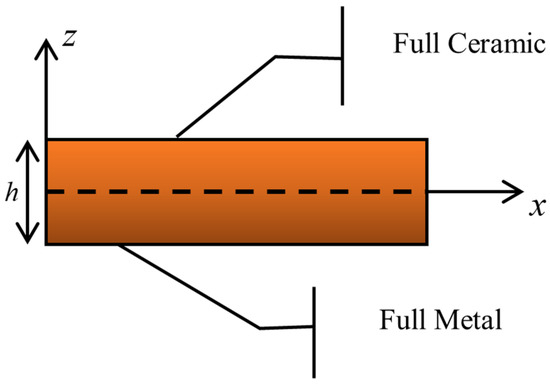
Figure 1.
Structure of power-law FGM.
Material properties of P-FGM depend on the p-value and the position in the plate and vary according to a power law according to Equation (1).
where p is a non-negative number called the volume fraction index, h is the thickness of the structure, and m and c indicate metal and ceramic components. According to the law of material distribution in Equation (1), when p = 0, the homogeneous plate is ceramic; when p ≥ 1, the proportion of ceramic in the P-FGM plate decreases.
2.2. Heat Transfer in P-FGM
Assuming that a P-FGM plate has three layers with each layer’s thickness of δ1, δ2, and δ3 (m) and the thermal conductivity of λ1, λ2, and λ3 (W/m∙temp), and the surface temperatures are ( − ), Figure 2 shows the layers affected by the temperature of the P-FGM plate.
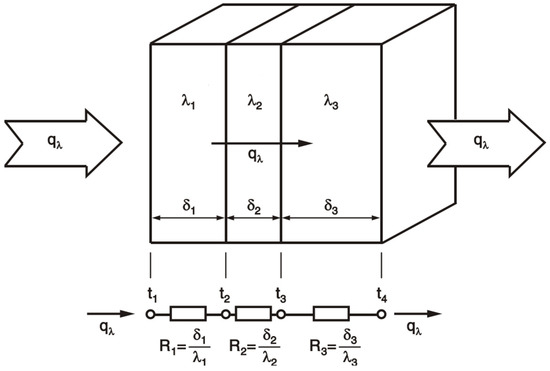
Figure 2.
Heat transfer model through P-FGM plate consisting of three layers.
Then, heat flux through the layers is calculated using Equation (2).
From Equation (2), the following relationship is defined.
( − ) is calculated using Equation (4), and the heat flux is estimated using Equation (5).
For the plate with n layers, the heat flux is estimated using Equation (6).
where is the thermal conductivity of a layer of the plate.
The heat flux of the contact layer of the plate is defined as
Therefore, the temperature of the layer is calculated as
3. Results
3.1. P-FGM Plate with Uniformly Distributed Load
For different FGM plates, bending under uniform load (), and the responses of simple support with the SSSS boundary condition were estimated. The material properties of the plate are shown in Table 1. Numerical results are compared with those of previous studies to show the reliability of the proposed P-FGM model. Figure 3 shows the P-FGM plate with its dimensions.

Table 1.
Material properties of P-FGM plate.
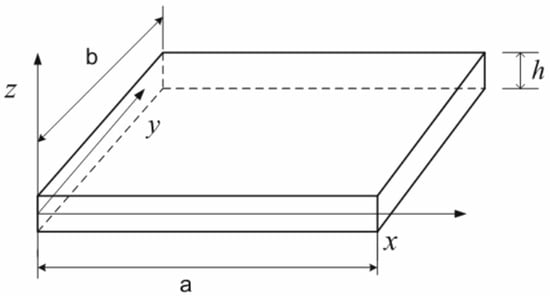
Figure 3.
FGM plate with dimensions.
For an elastic square plate with a surface on the x-y plane and a thickness in the z-direction, tensile (compression) modulus E is defined as a function of E = E(z), and Poisson’s ratio ν for smooth variation in thickness with a given rule is defined as a function of ν = ν(z). The square plate has a dimension of a × b × h = 100 × 100 × 10 or a/h = 10. As P-FGM has continuously varying mechanical properties, it was assumed that each layer of the P-FGM plate has different material parameters to model the plate in ANSYS Workbench. Using the power-law distribution, the details of 10 layers of the FGM plate were determined, as shown in Table 2.

Table 2.
Layer’s material properties of the P-FGM plate.
For the material properties with p = 2 and load with the SSSS boundary condition, the deflection and the von Mises stress of the P-FGM plate under a uniform load are shown in Figure 4 and Figure 5.
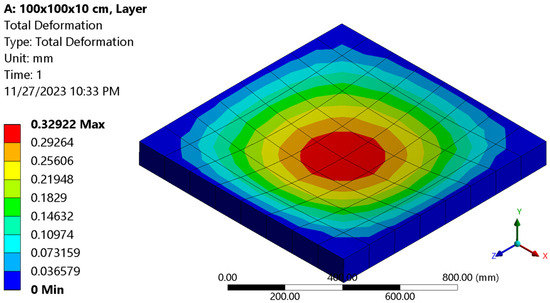
Figure 4.
Deflection of P-FGM plate.
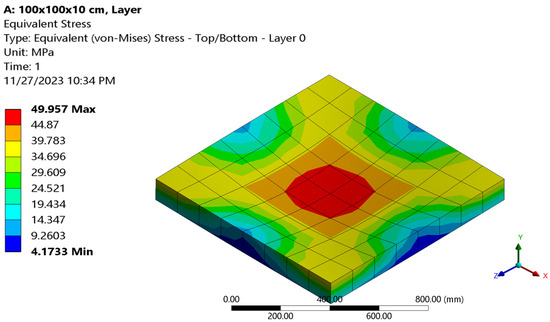
Figure 5.
von Mises stress of P-FGM plate.
The non-dimensional result of the modeled P-FGM was similar to that of Ref. [1]. The following equations were used to convert numerical results to non-dimensional ones in ANSYS Workbench [1].
Non-dimensional deflection of FG plate under uniform load was defined as
where is deflection in the center of the plate.
The non-dimensional von Mises stress of the P-FGM plate under uniform load was calculated as
where is von Mises stress in the center of the plate.
For the P-FGM plate with 10 layers, the result of the modeled plate in this research and the other research was compared, as shown in Table 3.

Table 3.
Non-dimensional result of P-FGM plate with 10 layers.
For the P-FGM plate with 20 layers, the result of the modeled plate in this research and the other research was compared, as shown in Table 4.

Table 4.
Non-dimensional result of P-FGM plate with 20 layers.
Remodeling the FG plate with 40 layers, the result of the modeled plate in this research and the other research was compared, as shown in Table 5.

Table 5.
Non-dimensional result of FGM plate with 40 layers.
The results of dimensionless deflection and von Mises stress in different volume ratios were compared in Figure 6 and Figure 7.
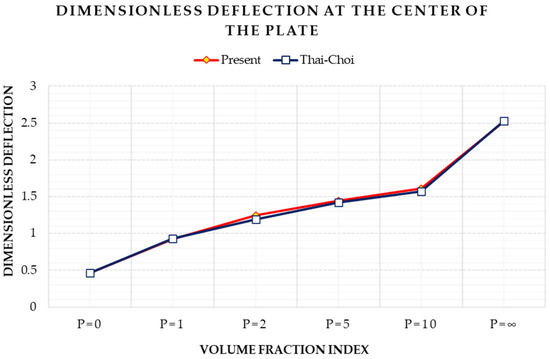
Figure 6.
Dimensionless deflection at center of plate.

Figure 7.
Dimensionless von Mises stress at center of plate.
3.2. Influence of Temperature
Assuming the elastic square plate of size 200 × 200 × 10 (mm), the square plate of P-FGM had a ceramic-rich top surface and metal-rich bottom surface, material parameters changed linearly according to the P-FGM model, and volume fraction index p = 2, it was found that the P-FGM plate was affected by temperature. The ceramic-rich surface endured heat up to 600 °C, and the metal-rich surface only afforded heat up to 20 °C. Details of the properties of ceramic and metal surfaces of the square plate are presented in Table 6.

Table 6.
Properties of ceramic and metal surfaces of P-FGM plate.
In this research, a steady heat transfer from one surface of the plate to the other was considered. By dividing the plate into many small layers and using their material properties, a solid plate model with dimensions of 200 × 200 × 10 (mm) was constructed, as shown in Figure 8.
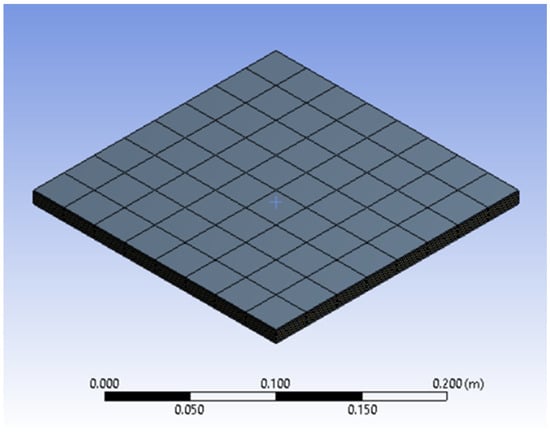
Figure 8.
FGM plate model with multi-layers.
Table 7 presents the details of 10 layers of the P-FGM plate of the size of 200 × 200 × 10 (mm).

Table 7.
Properties of 10 layers of P-FGM plate in 200 × 200 × 10 (mm).
Using the steady-state analysis in Ansys Workbench, the heat transfer of the plate was simulated, as shown in Figure 9.

Figure 9.
Heat transfer through plate.
The comparison of the results of the software simulation and the theory are shown in Table 8, which presents similar results for the two methods.

Table 8.
Comparison of heat transfer results simulated using software and calculated with theory.
4. Conclusions
The mechanical behavior and heat transfer properties of the P-FGM plate were explored in this research. Specifically, a model was established according to the power-law distribution. The result showed the maximum deflection and stress at the center of the plate, as well as the heat transfer through the layers of the plate. A comparison of the results of other research proved the reliability of this research’s model. It was found that the modeled P-FGM plate helped understand the properties and heat transfer of the plate and provided intuitive results. However, the model needs improvement as it was constructed based on the properties of the P-FGM plate estimated using software. Thus, variables might not be optimized for the model. This produced simple numerical results, which were not enough to explain the various problems in the plate’s structure. The research method using ANSYS also needs to be improved for the construction of a better model.
Author Contributions
Conceptualization, T.H.N.; methodology, N.T.N.; software, D.A.L.; validation, T.H.N.; formal analysis, N.T.N.; investigation, N.T.N. and D.A.L.; resources, T.H.N.; data curation, N.T.N. and D.A.L.; writing—original draft preparation, N.T.N.; writing—review and editing, T.N.T.; visualization, T.H.N.; supervision, T.H.N.; project administration, T.H.N. and T.N.T. All authors have read and agreed to the published version of the manuscript.
Funding
This research received no external funding.
Institutional Review Board Statement
Not applicable.
Informed Consent Statement
Not applicable.
Data Availability Statement
Data underlying the results presented in this paper are not publicly available at this time but may be obtained from the authors upon reasonable request.
Acknowledgments
We acknowledge Ho Chi Minh City University of Technology (HCMUT), VNU-HCM for supporting this study.
Conflicts of Interest
The authors declare no conflict of interest.
References
- Thai, H.-T.; Choi, D.-H. A simple first-order shear deformation theory for the bending and free vibration analysis of functionally graded plates. Compos. Struct. 2013, 101, 332–340. [Google Scholar] [CrossRef]
- Singha, M.K.; Prakash, T.; Ganapathi, M. Finite element analysis functionally graded material plates under transverse load. Finite Elem. Anal. Des. 2011, 47, 453–460. [Google Scholar] [CrossRef]
- Cooley, W.G. Application of Functionally Graded Materials in Aircraft Structures. Master’s Thesis, Air Force Institute of Technology, Dayton, OH, USA, 2005. [Google Scholar]
- Bich, D.H.; Do Long, V. Non-linear dynamical analysis of imperfect functionally graded material shallow shells. Vietnam. J. Mech. 2010, 32, 65–79. [Google Scholar] [CrossRef] [PubMed]
Disclaimer/Publisher’s Note: The statements, opinions and data contained in all publications are solely those of the individual author(s) and contributor(s) and not of MDPI and/or the editor(s). MDPI and/or the editor(s) disclaim responsibility for any injury to people or property resulting from any ideas, methods, instructions or products referred to in the content. |
© 2023 by the authors. Licensee MDPI, Basel, Switzerland. This article is an open access article distributed under the terms and conditions of the Creative Commons Attribution (CC BY) license (https://creativecommons.org/licenses/by/4.0/).